
The Muslim Moplahs of Malabar marked the beginning of an era of communal violence in twentieth century India. The Moplahs continued their work since the first organized attacks on Hindus by the Moplahs under Tipu Sultan's rule in the eighteenth century. In the nineteenth century, when Moplah farmers killed Hindu landlords, the British could not suppress the Moplahs. Nevertheless, the British helped the Hindu landlords a lot to stay on their lands.
By the turn of the twentieth century, the Moplahs regrouped and started killing Hindus. In AD 1921, the Moplahs, inspired by the Khalifa movement approved in the Karachi resolution of the Muslim League, started terrible violence against Nayar, Namboodiri and Jammi Hindu landowners. They killed thousands of Hindus and forced the poor Hindus to become Muslims.
Unable to cope with this violence, more than one lakh Hindus fled their homes which were captured by Moplah Muslims. This action brought about a demographic change in Kerala. When the British government made efforts to save the Hindus, the Muslims also attacked the British.
In British records these were recorded as British-Muslim rebellions. When the British administrators withdrew from the Moplah areas, the Moplah people again started harassing and killing Hindus. Muhammad Haji was declared the Caliph of the Moplah people and started hoisting the Caliph's flag throughout the region. Ernad and Valluvanad districts of Kerala were declared Sultanate of Caliphate.
The British did not let the news of the killing by the Moplahs come in front of the country for a long time, but Veer Savarkar revealed the whole massacre by writing a poignant novel. This caused great resentment among the Hindus. On this, the British sent armies from Garhwal, Nepal and Burma and sent them to Malabar. These forces killed 2,226 Moplah miscreants, injured 1,615 Moplah miscreants, 5,688 Moplah miscreants were taken prisoner and 38,256 Moplah miscreants surrendered to the British forces.
In the Moplah rebellion, instead of showing sympathy to the suffering Hindus, Gandhi sang the melody of Hindu-Muslim unity, which led to more resentment among the Hindus towards the Muslims and Gandhiji. Dr. Shivram Munje was so fed up with Gandhiji's policies that he started becoming indifferent to the Congress.
Mrs. Annie Besant has written about the Moplah-violence of AD 1921- 'The Moplahs killed and looted on a very large scale. Even the Hindus who were not opposing the Moplahs were killed. They were thrown out of their homes, looting everything of one lakh people. Malabar teaches us what is the real meaning of Islamic rule! We don't want to see another example of Khilafat Raj in India.'
When news of the suppression of Moplah miscreants were published in newspapers across the country, communal tension prevailed throughout the country. In Multan also Muslims killed many Hindus and looted or destroyed their property. Similar incidents happened in Saharanpur also. Communal riots also took place in Lahore. Swami Shraddhanand of Arya Samaj was murdered on his sick bed. Some other leaders of Arya Samaj were also murdered. These incidents disturbed the Hindu public.
Hindu Muslim riots of Kohat
In May 1924 a Muslim newspaper of Punjab 'Lahaul' I published an anti-Hindu poem, part of which was as follows-
You have to raise Teg-e-Muslim.
Krishna will burn your Gita.
In response to this the 'Hindu' of Jammu The newspaper also published a poem, part of which was as follows-
Will build a temple of Vishnu in Kaaba,
Namaji's reputation will have to be erased.
A person named Jeevandas 'Hindu' Received one thousand copies of the newspaper and sold 30-40 copies on the occasion of Krishna Janmashtami on 22 August 1924. When these copies reached the Muslims, they started attacking the Hindus. Hindu houses were burnt, 12 Hindus were killed, 13 Hindus went missing, 24 Hindu bodies were badly damaged, 62 Hindus were injured in general. In response, Hindus also attacked Muslims and riots started in Kohat.
Altogether 10 Muslims were killed, 1 or 2 Muslims were made missing, 6 Muslims were badly injured and 17 Muslims in general were injured. After this incident the Hindus were sent from Kohat to Rawalpindi. Gandhiji went to Rawalpindi thrice to help the Kohat riot victims but could not help them. Bhai Parmanand succeeded in helping the suffering Hindus with the help of the local Hindu Sabha.
